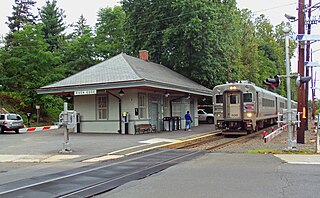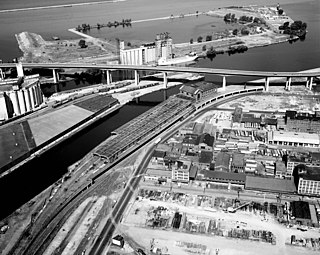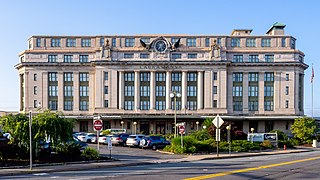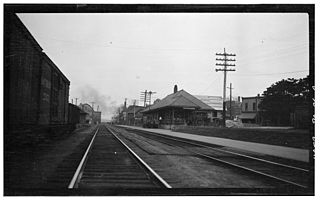Related Research Articles

The Delaware, Lackawanna and Western Railroad was a U.S. Class 1 railroad that connected Buffalo, New York, and Hoboken, New Jersey, a distance of 395 miles (636 km). Incorporated in Pennsylvania in 1853 primarily for the purpose of providing a connection between the anthracite coal fields of Pennsylvania's Coal Region and the large markets for coal in New York City. The railroad gradually expanded both East and West, eventually linking Buffalo with New York City.

The Erie Lackawanna Railway, known as the Erie Lackawanna Railroad until 1968, was formed from the 1960 merger of the Erie Railroad and the Delaware, Lackawanna & Western Railroad. The official motto of the line was "The Friendly Service Route".

The Pascack Valley Line is a commuter rail line operated by the Hoboken Division of New Jersey Transit, in the U.S. states of New Jersey and New York. The line runs north from Hoboken Terminal, through Hudson and Bergen counties in New Jersey, and into Rockland County, New York, terminating at Spring Valley. Service within New York is operated under contract with Metro-North Railroad. The line is named for the Pascack Valley region that it passes through in northern Bergen County. The line parallels the Pascack Brook for some distance. The line is colored purple on system maps, and its symbol is a pine tree.

The Main Line is a commuter rail line owned and operated by New Jersey Transit running from Suffern, New York to Hoboken, New Jersey, in the United States. It runs daily commuter service and was once the north–south main line of the Erie Railroad. It is colored yellow on NJ Transit system maps, and its symbol is a water wheel.

The Northern Branch is a railroad line that runs from Jersey City to Northvale in northeastern New Jersey, and formerly extended further into New York State. The line was constructed in 1859 by the Northern Railroad of New Jersey to connect the New York and Erie Railroad's Piermont Branch terminus in Piermont, New York, directly to Erie's primary terminal in Jersey City, initially Exchange Place, later Pavonia Terminal. In 1870 the line was extended to Nyack, New York, and continued to provide passenger service until 1966. After the Erie's unsuccessful merger with the Lackawanna Railroad to form the Erie-Lackawanna, ownership of the line passed into the hands of Conrail upon its formation in 1976 from a number of bankrupt railroads.

The Metro Rail Maintenance Yard or "South Park Terminal" houses Buffalo Metro Rail's cars in a train shed at the former Delaware, Lackawanna and Western Railroad terminal in the Cobblestone District of Buffalo, New York. The property is located at the southernmost fringe of the Central Business District. The station was built in 1917, and was designed to handle both steam trains and steamships. The storage and maintenance facility was converted to its present condition in 1982, following the demolition of the former main terminal concourse building "headhouse" of the DL&W Terminal in 1979.

Pavonia Terminal was the Erie Railroad terminal on the Hudson River situated on the landfilled Harsimus Cove in Jersey City, New Jersey. The station opened in 1861 and closed in 1958 when the Erie Railroad moved its passenger services to nearby Hoboken Terminal. The New York, Susquehanna and Western Railway also ran commuter trains from the terminal and various street cars, ferries and the underground Hudson and Manhattan Railroad serviced the station. The station was abandoned in 1958 and demolished in 1961. The site was eventually redeveloped into the Newport district in the late 20th century.

Paterson is a New Jersey Transit commuter railway station located on an elevated viaduct above Market Street in downtown Paterson, New Jersey. The railway through the station is double tracked, for north and south traffic on the NJT Main Line.

The Radisson Lackawanna Station Hotel, which was built as the Delaware, Lackawanna and Western Railroad Station, is a French Renaissance-style building in Scranton, Pennsylvania.

The Central Railroad of New Jersey Freight Station in Scranton, Pennsylvania, United States, was the western terminus of the Central Railroad of New Jersey line, 192 miles (309 km) from its base of operations in Jersey City, New Jersey. Located on West Lackawanna Avenue, over the Lackawanna River from downtown Scranton, near Steamtown National Historic Site, it is to be distinguished from the other legacy Scranton station, Delaware, Lackawanna & Western Scranton Station, where service persisted to January 6, 1970.

The Lake Cities was a passenger train operated by the Erie Railroad and successor Erie Lackawanna Railway between Chicago and New Jersey termini — first, Jersey City and later Hoboken.

Railroad Terminal Historic District is a national historic district in Binghamton in Broome County, New York. The district includes 19 contributing buildings. Four of the buildings were directly related to Binghamton's rail passenger and freight operations, including the passenger station. Five buildings were built as warehouses, and ten were built to house retail activities with residential or office uses on the upper floors. The buildings were built between 1876 and 1910, with a major addition to one of them completed in 1932. This Delaware, Lackawanna and Western Railroad passenger station, with its Italian Renaissance campanile, was built in 1901. For most years of passenger service to Binghamton, Delaware and Hudson Railway and Erie Railroad trains used a different station 150 yards away.

Pocono Mountain is a proposed New Jersey Transit Rail Operations (NJT) station located in Coolbaugh Township, Monroe County, Pennsylvania and is part of a site that was formerly utilized as a summer camp. The proposed station site, which will include a 1,000-space surface parking lot, is located northwest of a multi-phased planned development for this area. Access will be from Pennsylvania Route 611 via Pocono Municipal Road/Mount Pocono Road and a local access road and the platform would be situated east of the track.

Phoebe Snow was a named passenger train which was once operated by the Delaware, Lackawanna and Western Railroad (DL&W) and, after a brief hiatus, the Erie Lackawanna Railway (EL).

The Nickel Plate Limited, later known as the City of Cleveland and City of Chicago, was a passenger night train operated by the New York, Chicago and St. Louis Railroad between Chicago and Buffalo, New York via Cleveland, Ohio, with through service to Hoboken, New Jersey via Binghamton and Scranton and the Delaware, Lackawanna and Western Railroad for the Buffalo-Hoboken segment.

Warren was a former station for the Erie Railroad on its main line and on the Mahoning Division's first subdivision between Cleveland and Pymatuning station. Along the main line, the next station west towards Dearborn Station was Leavittsburg, while east towards Pavonia Terminal was Niles. The station was located 585.7 miles (942.6 km) from Pavonia Terminal and 412.8 miles (664.3 km) from Dearborn Station.

Cambridge Springs was a railroad station for the Erie Railroad in Cambridge Springs, Crawford County, Pennsylvania, United States. Cambridge Springs station was on the Main Line's Meadville Division, which was the section of the line between Salamanca, New York, and Meadville, Pennsylvania. The station was located 501.2 miles (806.6 km) from Manhattan and the Barclay Street Ferry, which connected to Pavonia Terminal in Jersey City, New Jersey, and 480.8 miles (773.8 km) from Hoboken Terminal in Hoboken, New Jersey. For nearly three decades, the station had connections to the Northwestern Pennsylvania Railway, which was a trolley line that connected the city of Erie and Meadville. Modern Erie Railroad station signage denoted the station as "Home of Alliance College," a local private university that closed in 1987.

The Erie Limited was a streamlined passenger train operated by the Erie Railroad between Jersey City, New Jersey and Chicago, Illinois via the Southern Tier. It operated from 1929 to 1963. After the merger of the Erie and the Delaware, Lackawanna and Western Railroad (DL&W) in 1960 it was known as the Erie-Lackawanna Limited. Once the premier passenger train on the Erie, repeated service reductions in the 1950s and 1960s left it a shell of its former self. The Phoebe Snow replaced it in 1963.

Marion Union Station is a former passenger railroad station at 532 W. Center Street in Marion, Ohio, United States. As a union station it served several train lines: the Chesapeake and Ohio Railway, Cleveland, Cincinnati, Chicago and St. Louis Railway or CCC & St. L., and Erie Railroad. These lines intersected at the station, so it was a significant transfer point between different geographic points.

Youngstown was a station along the Erie Railroad and later the Erie-Lackawanna Railway, from 1922 to 1977 in Youngstown, Ohio. All railroad tracks behind the terminal have been removed, and the building is currently known as Erie Terminal Place, alternative student housing for students attending Youngstown State University.
References
- ↑ Sanders, Craig (2003). Limiteds, Locals, and Expresses in Indiana, 1838–1971. Bloomington, Indiana: Indiana University Press. ISBN 978-0-253-34216-4.
- ↑ 'Official Guide of the Railways,' December 1954, Erie Railroad section, Table 2, 3, 8
- ↑ Erie Railroad timetable, April 1958, Table 4
- ↑ 'Official Guide of the Railways,' June 1961, Erie-Lackawanna section, Table 5, 6
